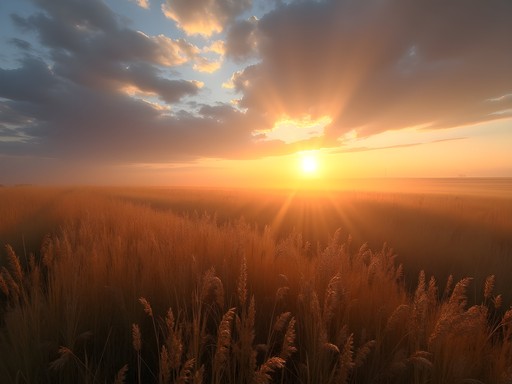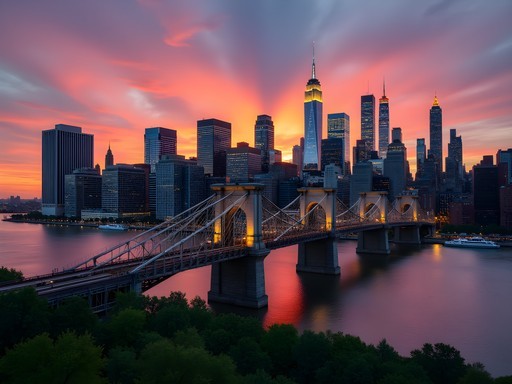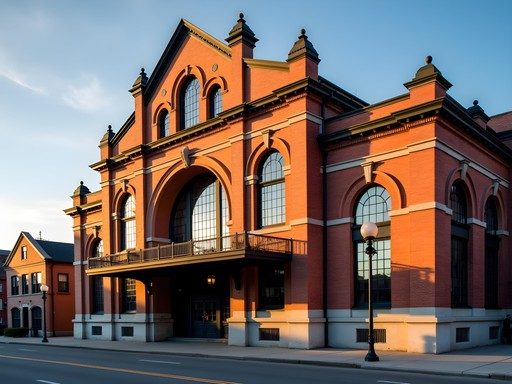Disclosure: This article contains affiliate links. We may earn a commission from purchases at no extra cost to you, which helps our travel content.
The first time I encountered South Dakota's prairie landscapes, I was reminded of the abstract canvases I'd studied in art school – vast horizontal bands of color that shift with the light, punctuated by occasional vertical elements that command attention. After years photographing the dramatic peaks of the Himalayas and the chaotic energy of Southeast Asian markets, I found myself unexpectedly captivated by the subtle power of Huron's prairie landscapes – a visual meditation that rewards the patient observer with extraordinary moments of light, texture, and space.
The Prairie Light: Understanding Huron's Golden Hours
There's something almost mystical about prairie light that defies conventional photography wisdom. In Huron, the absence of mountains means sunrise and sunset stretch longer, with a quality of illumination that transforms ordinary scenes into extraordinary canvases. The low angle of autumn sunlight creates dramatic shadows across the textured grasslands, while the cooler temperatures minimize the heat haze that can soften summer images.
I've found that arriving at locations 45 minutes before official sunrise provides the best opportunity to capture the transition from blue hour to golden light washing across the prairie. The James River Valley, just east of town, offers unobstructed eastern views where morning fog often hovers just above the grasslands, creating ethereal conditions as the sun breaks through.
For sunset shoots, the agricultural fields west of Huron provide perfect foregrounds of harvested crops against the painted sky. The remnants of corn and sunflower fields create compelling textural elements that catch the last light in ways that continually surprise me. My light meter has proven invaluable here, as the prairie's expansive brightness range can easily fool your camera's internal metering.

💡 Pro Tips
- Scout locations during midday to plan compositions, then return during golden hour
- Bring graduated ND filters to balance bright skies with darker foregrounds
- Use the weather forecast to anticipate fog conditions along the James River
Texture and Pattern: Compositional Strategies for Prairie Photography
The apparent simplicity of prairie landscapes challenges photographers to find compelling compositions where others might see emptiness. This is where my background in graphic design becomes my secret advantage. The prairie is a study in texture, pattern, and subtle variations that reward careful observation.
At first glance, Huron's landscape appears flat, but spend time walking the native grasslands at the Dakota Nature Park, and you'll discover micro-topographies that create fascinating foreground elements. Get low – I often find myself lying prone in the grass with my ground cloth to protect my gear – and suddenly those grass seedheads become dramatic elements against the sky.
The agricultural patterns surrounding Huron offer another compositional opportunity. In autumn, the geometric precision of harvested fields creates stunning abstract patterns best captured from elevated positions. The water tower at Ravine Lake provides one such vantage point, while my drone has become indispensable for revealing the patchwork quilt of farmland stretching toward the horizon. Just remember to respect local drone regulations and private property boundaries.

💡 Pro Tips
- Use a wide-angle lens close to foreground elements to create depth in seemingly flat landscapes
- Look for natural leading lines in field rows, fence lines, and dirt roads
- Incorporate negative space intentionally – emptiness can be as powerful as subject matter
Prairie Wildlife: Patience and Preparation
The prairies around Huron host a surprising diversity of wildlife for the prepared photographer. My journeys across the Himalayas taught me that patience is the ultimate wildlife photography skill – a lesson that serves equally well on the Great Plains. The wetland areas northeast of Huron, particularly around Byron Bible Camp, offer exceptional bird photography opportunities during fall migration.
I've spent dawn hours concealed in my portable blind watching as thousands of waterfowl take flight against the rising sun – a spectacle that rivals anything I've witnessed in more famous wildlife destinations. The key is arriving well before first light and remaining absolutely still as the world awakens around you.
For mammal photography, the grasslands along the James River Valley hide white-tailed deer, foxes, and occasionally coyotes. Rather than hiking extensively, I've found success by identifying game trails near water sources and setting up downwind with my telephoto lens. The prairie winds can be challenging for long lens work, so I always pack my bean bag for stabilization against my vehicle or natural supports.

💡 Pro Tips
- Research migration patterns to time your visit with peak bird activity
- Use natural blinds like tall grass clumps rather than moving around frequently
- Focus on water sources during early morning and late evening hours
Weather Drama: Embracing the Elements
If there's one thing I've learned from my years documenting landscapes across continents, it's that 'bad' weather often makes for the most compelling photographs. Nowhere is this more true than on the Great Plains, where weather systems sweep across the landscape with theatrical flair.
Fall in Huron brings rapidly changing conditions that create dramatic photographic opportunities for those willing to brave the elements. I've captured some of my most powerful images as storm fronts approach from the west, creating a chiaroscuro effect across the landscape that emphasizes texture and form. The contrast between sunlit foregrounds and ominous storm clouds can be breathtaking.
Staying weather-aware is essential, as conditions can change rapidly. I rely on my weather radio when cell service is spotty in remote areas. For protection against sudden downpours, my camera rain cover has saved countless shoots. And don't underestimate the wind – prairie gusts can easily topple a tripod, which is why I always carry a sandbag that I can fill with local materials when needed.

💡 Pro Tips
- Monitor weather radar apps to position yourself ahead of approaching storm fronts
- Use polarizing filters to enhance cloud definition and control reflections
- Protect your gear from dust – prairie winds can kick up significant particulates
Cultural Elements: Contextualizing the Prairie
As someone who has spent years documenting the intersection of landscape and culture across Asia and Europe, I find Huron's human elements equally compelling subjects. The architectural remnants of prairie settlement – weathered barns, abandoned homesteads, grain elevators rising like cathedrals from the flat horizon – tell stories as profound as any ancient temple I've photographed in the Himalayas.
The Beadle County Historical Society provides maps of historic structures that make for excellent photographic subjects. I've spent entire mornings photographing a single abandoned farmhouse, watching as changing light reveals the textures of weathered wood and the poignant evidence of lives once lived on the prairie.
Huron's agricultural heritage offers another cultural dimension. During harvest season, the activity of combines moving across vast fields creates dynamic scenes that capture the relationship between people and this landscape. For these documentary moments, I often switch to my fixed lens for its versatility in changing light conditions and ability to capture environmental portraits of the people working the land.
Don't overlook Huron's small-town architecture either. The historic downtown buildings and the impressive World's Largest Pheasant sculpture provide whimsical counterpoints to the natural landscapes.

💡 Pro Tips
- Ask permission before photographing working farms or private structures
- Visit the local historical society for context and location information
- Incorporate human elements to provide scale in vast prairie landscapes
Final Thoughts
As I pack my gear after a final sunset shoot over Ravine Lake, I find myself reflecting on how these seemingly simple prairie landscapes have challenged and expanded my photographic vision. Like the abstract canvases that first drew me to art, Huron's Great Plains reveal their complexity slowly, rewarding those who linger with moments of transcendent beauty.
What appears empty at first glance becomes rich with detail, pattern, and story when approached with patience and openness. This is the true gift of prairie photography – it teaches us to see differently, to appreciate subtlety, to find extraordinary beauty in ordinary places.
I came to Huron expecting a brief stopover on my way to more dramatic landscapes. Instead, I found a photographic experience that has fundamentally shifted how I approach light, composition, and the relationship between land and sky. Whether you're a seasoned photographer or just beginning to explore visual storytelling, Huron's prairie landscapes offer a masterclass in seeing beneath the surface – a skill that will transform your work no matter where your camera takes you next.
✨ Key Takeaways
- Prairie photography rewards patience and careful observation of light conditions
- Getting low and looking for textural elements creates depth in seemingly flat landscapes
- Weather patterns create dramatic opportunities for unique images
- Cultural elements provide historical context and human scale to natural landscapes
📋 Practical Information
Best Time to Visit
Mid-September to early November
Budget Estimate
$300-500 for a weekend (accommodation, car rental, meals)
Recommended Duration
3-4 days minimum
Difficulty Level
Intermediate
















Comments
Timothy Jenkins
Brilliant piece on what many photographers overlook as 'empty' landscapes. I documented the grasslands of South Dakota last summer and found myself constantly challenged by the subtle interplay of light and texture. Your section on compositional strategies resonated deeply - finding those leading lines amidst the grass can transform an image. I've found that my polarizing filter made a tremendous difference in bringing out cloud detail and controlling reflections on dewy morning grass. The cultural history of the region adds another fascinating layer - did you engage with any of the local communities about their relationship with the landscape? Their perspectives often reveal visual elements we might otherwise miss.
greenlife
Those sunset shots over Ravine Lake are incredible! Added Huron to my photography bucket list!
wavewalker
Beautiful photos! I'm heading to South Dakota next month but I'm just an amateur with a basic camera. Any tips for capturing those big skies without fancy equipment?
Amit Sanchez
Absolutely! Even with basic gear, you can get amazing prairie shots. Try shooting panoramas by stitching multiple photos together. And don't underestimate your smartphone - the wide angle lens is perfect for those expansive views. Most importantly, focus on timing - early morning and late afternoon light will elevate any camera's capabilities!
Jean Wells
I'd add that composition becomes even more important with simpler equipment. Look for foreground elements like wildflowers or interesting grasses to create depth. And don't be afraid of cloudy days - they can actually create more dramatic light on the prairies than clear blue skies.
wavewalker
Thanks for the tips! Just got back and you were right about the morning light - totally magical even with my old Canon!
skylover
I've always driven through the prairies on my way somewhere else, but your post has me wanting to actually stop and spend time there. Those storm cloud photos are incredible! Do you think spring or fall is better for photography there? I'm planning a road trip and could do either season.
photomaster
Not the author but I've shot in both seasons - fall has those amazing golden grasses but spring has wildflowers and more dramatic storms in my experience.
Amit Sanchez
Photomaster is right! Both seasons have their charm. Spring brings those incredible thunderstorms and fresh green hues, while fall offers warmer tones and clearer air. If I had to choose, I'd lean toward late September for the most photogenic conditions.
Jean Wells
Amit, your analysis of prairie light is spot on. I've photographed landscapes across four continents, but the Great Plains present unique challenges and rewards. When I visited South Dakota in 2023, I found myself constantly adjusting my approach. The prairie demands patience - what appears monotonous at first glance reveals incredible subtlety when you wait for the right conditions. I particularly appreciated your section on weather drama. I spent three days near Huron waiting for a storm front, and the resulting images of lightning over those grasslands remain among my portfolio favorites. For those planning a visit, I'd add that a graduated ND filter is essential for balancing those vast skies with the foreground. My filter set proved invaluable throughout the Midwest.
freeclimber
Man, this post takes me back! I drove through South Dakota last summer and was blown away by those prairie landscapes. Everyone talks about the Badlands and Black Hills, but there's something hypnotic about those endless grasslands. The way the light plays across them at sunset is unreal. Did you find it challenging to capture the sense of scale? That was my biggest struggle - everything looks so flat in photos compared to being there.
Amit Sanchez
Thanks freeclimber! Scale is definitely one of the biggest challenges. I found including fence posts or isolated trees really helps provide that sense of vastness. Also, shooting during golden hour when you get those long shadows across the grass adds so much dimension!
freeclimber
That makes total sense. Gonna try that next time I'm out in open country!
luckyperson
Just got back from Huron last week! Your tips would have been so helpful. The light there is something else!
Mason Ferrari
Having photographed across multiple biomes, I find prairie landscapes present a unique challenge in composition. The apparent simplicity demands more attention to subtle details. I spent three days at Ravine Lake last autumn and found that using graduated ND filters was essential for balancing the dramatic sky with the foreground textures. The section on weather patterns is particularly insightful - I've observed that approaching weather systems create the most dynamic light conditions about 30-45 minutes before their arrival. Did you find any particular focal length most effective for capturing the essence of the prairie's vastness?
Amit Sanchez
Great observations about the approaching weather systems, Mason. For focal lengths, I found myself gravitating toward 24-35mm for most landscapes to capture that sense of vastness, but occasionally used 50mm to isolate interesting textural elements in the grass when the light was particularly dramatic.
beachstar
I'm headed to South Dakota next month but only have my phone camera. Worth trying to capture those landscapes or should I invest in something better?
Amit Sanchez
Modern phone cameras can actually capture prairie landscapes quite well! For the best results, use your phone's HDR mode and a small tripod for stability during golden hour. The panorama feature is also perfect for those wide horizons.
beachstar
Thanks Amit! That's a relief - will definitely try the panorama tip!
photomaster
Those golden hour shots are breathtaking! Never thought of prairies as being so photogenic.
Venture X
Premium card with 2X miles, $300 travel credit, Priority Pass